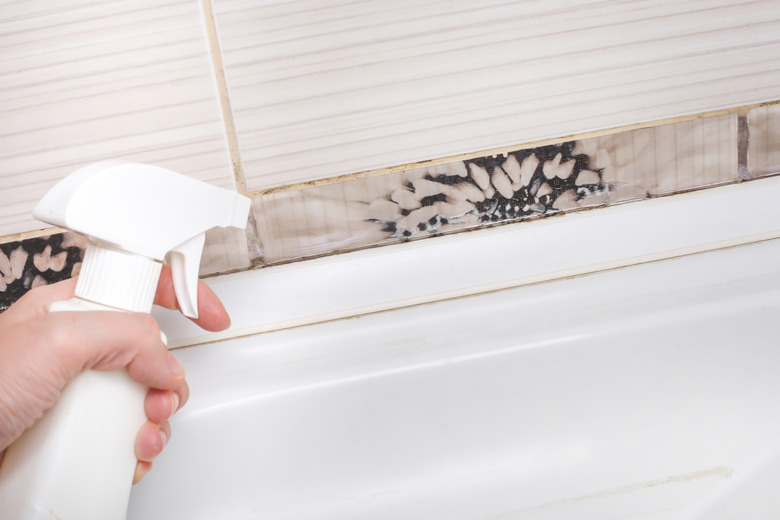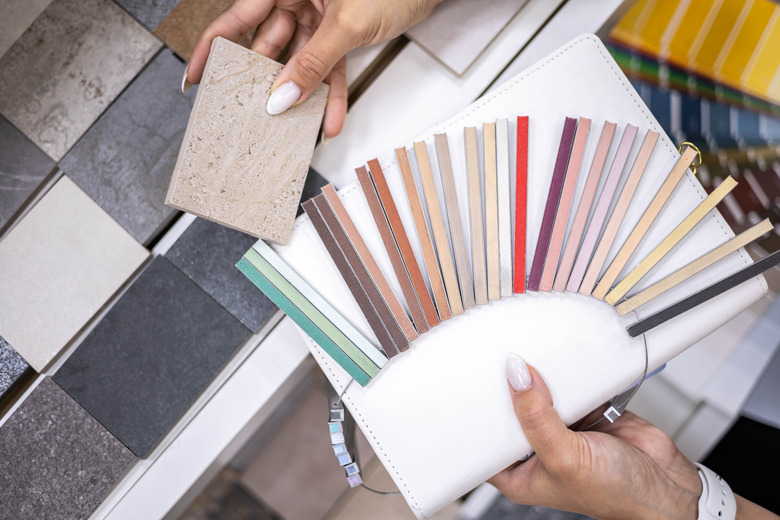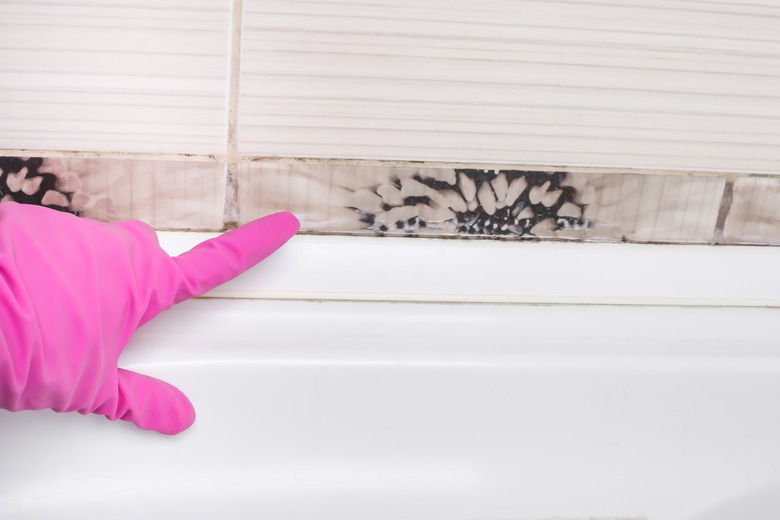Can You Caulk Over Grout?
We may receive a commission on purchases made from links.
When you see discolored and deteriorating grout in your shower around the bathtub or some other place in the house, you may be asking yourself: "Can you caulk over grout?" That would certainly be a fast and easy way to improve the situation, and the answer to the question is yes. You can caulk over grout, but that doesn't mean it's the best way to handle things.
When old caulk deteriorates, the best way to fix it is to re-grout. That's a big job for sure, but it will make a huge difference. Grout is the unsung hero of interior design features, and when you renew it, it freshens the appearance of the room as effectively as new paint.
To do the job properly, you need to remove all the old grout, but if you don't have time for that, you're not out of options. Instead of asking "can you caulk over grout?" you should ask "can you grout over grout?" That's also a straightforward yes, but there are a few things you need to know if you want to make that old grout look new again.
Can You Caulk Over Grout?
Can You Caulk Over Grout?
Pretty much every tile expert will say the same thing: You can caulk over grout, but that doesn't mean you should. Caulk adheres well to almost anything, including tile grout (as long as the grout is dry), and caulking can be an efficient way to hide hairline cracks and fill small voids. However, consider these reasons to think twice before using it:
- Caulk will eventually begin to peel, and if you've used it to cover cracked grout, water will be able to get through the cracks and under the tiles, and the tiles could loosen and fall out.
- When caulk starts peeling and moisture gets behind it, mold and mildew will grow. Grout is porous, and when mold spores get established in the pores, they are very difficult to remove, especially with a layer of caulk lying over the area. Once mold has such a foothold, it can easily spread.
- Caulk doesn't look like grout. It's shinier, it has a smoother texture than sanded grout, and it's bound to be a different color. You may have to caulk entire grout lines to prevent the grout from looking spotty and ruining the appearance of the tiles.
- Caulk doesn't have the solidity of grout, and if you use it to fill large voids, it will slump and look terrible.
If you decide to proceed in spite of these drawbacks, it's essential to first clean the old grout, and it's also a good idea to apply a sealer. This may help stop mold from sinking into it when the old caulk starts peeling away.
Can You Grout Over Grout?
Can You Grout Over Grout?
You can definitely re-grout tile, which requires removing all the old tile grout. This is a fairly straightforward DIY home improvement project that doesn't call for professional expertise, but it can be time-consuming. So, can you re-grout tile without removing old grout? Yes, but first some preparation is required.
Even though large-scale grout removal isn't part of the plan, you do have to scrape enough off the existing grout to make a channel that allows you to apply a coating of new grout that is thick enough to resist cracking. You can usually do this scraping with a grout saw or some other manual grout removal tool.
It's also important to remove any of the existing grout that is loose and chipping away, which you can also do with a handheld grout removal tool. If you have to remove a lot of loose grout from a grout line, you should consider going all the way and removing all of it.
Tip
If you have to re-grout a large area, consider using a rotary tool with a grinding attachment to save time. When removing grout in preparation for complete re-grouting, using an oscillating tool with a grout removal blade is the fastest way. Be careful to avoid scratching the tiles when using either of these tools.
How to Remove Dried Grout From Tile
How to Remove Dried Grout From Tile
If grout has dried on your tiles but it hasn't yet had time to cure, you can usually wipe it off with a damp rag. Once the grout cures, which takes from 24 to 48 hours, it's more difficult to remove, and wiping alone won't cut it. You might be able to scrape it off, but because there's a danger of damaging the tiles, this might not work.
The best strategy for tough situations is a combination of dissolving and scraping the grout. For glazed porcelain and ceramic tile, dabbing the grout with full-strength vinegar while you scrape usually works, but you can't use vinegar or anything acidic on unglazed or stone tiles without risk of damaging them. For these tiles, consult your tile supplier or installer or a local stone tile dealer for recommendations specific to the stone you have.
Does Grout Dry Lighter?
Does Grout Dry Lighter?
Pretty much any porous material, including wood, concrete, and brick, appears darker when it's wet, and the same is true of sanded and unsanded cementitious grout. That means it will lighten up when it dries, sometimes by several shades. This doesn't happen as much with epoxy or premixed urethane grouts because they don't contain any water.
If you're unhappy with the grout color after it dries, you can usually restore the darker shade by applying a grout sealer. Some sealers even contain pigments that allow you to get an even darker shade that the grout had when it was wet.
How to Fix Cracked Grout
How to Fix Cracked Grout
It's common for grout to crack in only a few places on a tile installation, and while this kind of damage isn't major, it can ruin the appearance of the whole installation. You can fix these small cracks by following a simple procedure:
- Clean the cracked grout with a one-to-one solution of vinegar and water. If the tiles are unglazed or stone, use a nonacidic cleaner, such as dish soap and water. Avoid bleach.
- Scrape out the damaged grout. To allow the new grout to make a strong bond, remove the cracked grout all the way down to the tile backer.
- Moisten the surrounding tile with a damp sponge. This also helps the new grout make a strong bond.
- Mix the grout with water to make enough to fill all the voids you've created. It's a good idea to include some latex additive. Additives make the grout stronger and less likely to crack again. Let the mixture slake for 10 minutes after mixing.
- Use a grout float to force the grout into the voids in the grout lines. Wipe excess grout off the tiles with a damp sponge and then let the grout harden.
- Wipe grout haze off the tiles with a microfiber cloth.
- Wait for the grout to cure as directed, then seal it.
Tip
You probably won't get an exact color match between the new and existing grout. A good remedy for this is to use grout with a lighter color and change the color with a pigmented sealer.
Can I Patch Holes in Shower Grout?
Can I Patch Holes in Shower Grout?
Shower grout repair isn't much different than grout repair on other tile surfaces, such as countertops, floors, and walls. When grout on a shower wall or shower pan cracks or crumbles, the best shower grout repair strategy for a homeowner is to dig out the damaged grout and apply new grout. There's one instance, however, in which the repair is easier, and it doesn't involve caulk.
Years of exposure to water sometimes produces small pinholes in shower grout, and you can use grout to fix them. Simply clean the old grout and then mix up a batch of new grout — unsanded grout will work best — and force it into the pinholes with a grout float. Use this technique only on grout that has developed pinholes from water damage but is otherwise in good condition.
Can You Paint Grout?
Can You Paint Grout?
Yes, you can paint grout, but you need grout paint, which is a product specifically formulated for grout. It's epoxy- or silicone-based, so it will last much longer than ordinary paint. You can find products in easy-to-use squeeze tubes. Grout paint will discolor unglazed or stone tiles unless you seal them first, but you can use it with abandon on any glazed ceramic or porcelain tile installation.
Should I Stain Unevenly Colored Grout?
Should I Stain Unevenly Colored Grout?
Variations in color are to be expected in new grout. Sometimes, the tiles absorb water more quickly from some areas than others, causing the grout to dry unevenly. Sometimes, it's something as simple as the sun shining on one part of the tile installation and not on another, and of course, poor workmanship is another possible cause.
You may be able to even out the color with a grout stain, but you should test it in an unobtrusive area to make sure you're satisfied with the color before committing to it. Grout paint is another option that will ensure uniform color no matter what.
What Causes Pinholes in Grout?
What Causes Pinholes in Grout?
The main cause of pinholes in grout is too much water in the grout mixture. The excess water creates air bubbles, and they leave small holes when the air finally escapes. Sometimes, even well-mixed grout will develop pinholes when exposed to water for a long time, such as what happens inside a shower.
Should I Grout or Caulk?
Should I Grout or Caulk?
By now, it should be pretty clear that caulking over old grout is not the best repair strategy, but when you're grouting new tile, there are situations in which it's better to use caulk. For instance, if you're trying to decide whether to grout or caulk shower corners, most tilers would choose silicone caulk. You usually have a hard time trying to force grout into tight corners with a grout float, and silicone caulk makes a reliable, waterproof seal.
The issue of whether to grout or caulk around a tub when you are tiling bathroom walls or floors is also typically resolved in favor of caulk. It's a lot easier to put a caulk tube into a caulk gun and lay a clean caulk line in a tight corner than it is to try to force in grout.
Another instance in which caulk is preferable to grout is around borders of a tile installation, such as a backsplash, that are enclosed with wood or metal trim. Acrylic latex caulk (painter's caulk) is a better choice than silicone if your renovations call for the trim to be painted.
|
Can I caulk over grout? Yes, but it isn't a good idea. Can I grout over grout? Yes, and it's better than caulking. How do I remove dried grout from tile? Use a combination of wiping, dissolving, and scraping. Does grout lighten as it dries? Yes, but you can re-darken it with stain. How do I fix cracked grout? Remove all of the cracked material and re-grout that area. Can I patch holes in shower grout? Yes, you can apply new grout. Can I paint grout? Yes, you can. Use grout paint. Should I stain unevenly colored grout? You can, but painting is probably more efficient. What causes pinholes in grout? Pinholes develop when the grout mixture has too much water. Should I grout or caulk? Most of the time, you should grout, but there are situations in which caulk is better. |


